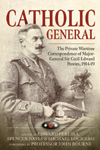|
CATHOLIC GENERAL
The Private Correspondence of
Major-General Sir Cecil Edward Pereira, 1914-19
Edited by Edward Pereira, Spencer Jones & Michael LoCicero
|
 Cecil Pereira joined the Coldstream Guards in 1890 and took command of the 2nd Battalion in late 1913. His letters in this compilation begin just a few days before the outbreak of The Great War. On 1st August, Cecil writes to his wife Helen ‘The great powers are sliding down the precipice, what an almighty bump there will be at the bottom’. In his letters he conveys a real sense of time and place and is open about his feelings. On 12th August, at Southampton, he writes ‘I am slowly realising that I am really leaving home and all that it holds; with all the business of mobilisation it was hard to realise, and I felt stunned by it all’. Cecil Pereira joined the Coldstream Guards in 1890 and took command of the 2nd Battalion in late 1913. His letters in this compilation begin just a few days before the outbreak of The Great War. On 1st August, Cecil writes to his wife Helen ‘The great powers are sliding down the precipice, what an almighty bump there will be at the bottom’. In his letters he conveys a real sense of time and place and is open about his feelings. On 12th August, at Southampton, he writes ‘I am slowly realising that I am really leaving home and all that it holds; with all the business of mobilisation it was hard to realise, and I felt stunned by it all’.
Soon, the Coldstream are in France, and Cecil captures something of the unreality of those early days: ‘This country is typically English and it is hard to realise that we are not on manoeuvres; no doubt shortly we shall find it easy enough to realise. We have heard the sound of guns like we used to in Sussex, a long way off’. Cecil is careful with security, ‘Once again it becomes difficult to write for fear of disclosing anything’, and yet, from a human and historical perspective he paints a vivid picture. On 14th October 1914, the Coldstream are relieved by a reserve battalion of the French Army, and Cecil is not impressed. They arrive ‘without transport or food or extra ammunition’. They appear ‘quite astonished at our fieldworks’ and Cecil predicts that within a week of occupying their new trenches, the place ‘will be indescribably foul and no additional strengthening will have been done’. Judging from the observations of many others about the state of French hygiene in the trenches, he was almost certainly right.
By the end of the war, Cecil Pereira is a divisional commander, having commanded 1st Guards Brigade in Flanders and later on the Somme. He continues to write several letters a week, while also receiving letters from home and elsewhere. The letters from Helen are full of family news and commentary about the bigger picture of the war, what the newspapers are saying, etc. Cecil’s letters describe life at the front, but without some of added frisson of late 1914, although by the spring of 1918 the pace increases considerably. There is much talk of other friends and acquaintances at the front; the Brigade of Guards is a closely-knit formation, and there is a sense that everyone seems to know everyone, certainly among the diminishing numbers of pre-war regular officers. One of the highpoints in 1916 is the Guards Division attacks on the Somme, in September. Cecil, on 17th September, tells Helen that at ‘the beginning of its advance [the Brigade] walked through machine gun fire that would have stopped nearly any troops except the Guards Division’ and yet at the same time he is ‘proud and miserable’, since the ‘percentage of wounds is enormous’.
Cecil Pereira received little training for formation command and, like many of his contemporaries, he learnt by experience. On 27th October 1918, he writes to his wife: ‘I am afraid you will be disappointed to hear that the Corps Commander has got his knife into me and once things happen one never knows what may occur’. Nonetheless, he survives in his post. As John Bourne says in his Foreword, apart from professional skills and character, he was sustained through the war by ‘his Christian faith (he was a devout Roman Catholic) and a stable and happy marriage’.
Cecil Pereira’s legacy of correspondence provides fascinating reading and many insights into the human dimensions of war. This book has excellent commentaries and footnotes; it is an invaluable addition to our knowledge and understanding of the First Worlds War.
The Editor
Published by Helion & Co. www.helion.co.uk.
Paperback. £29.95
|
|